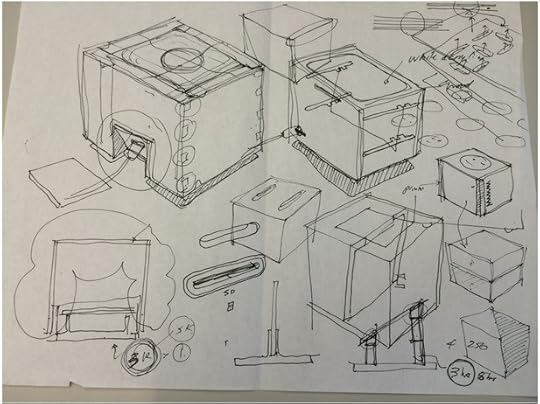Kill Screen Magazine's Blog, page 352
August 12, 2014
Titanic explorer David Gallo sets his sights on videogames
Talking World of Tanks and ocean mysteries with titanicguy2010.
August 11, 2014
Path to Thalamus explores the tragedy of a comatose mind
Few things seem more maddening than being trapped inside your own mind. As revealed on an episode of Radiolab a few years back, coma patients often aren't left in just blank unconscious like we imagine them to be. In the case of Emilie Gossiaux, who suffered a deadly collision with an 18-wheeler, she found herself in a netherworld of fear, hostility, and darkness. Through a miracle, she sometimes managed to communicate through this netherworld to the loved ones around her. She'd ask them to "pull her out of the wall" and begged them to help her escape the hostile dark over and over again.
Mind: Path to Thalamus is the story of a comatose father who cannot escape his inner world of regret at the loss of his daughter, Sophia. "How many times will I kill her?" the teaser trailer asks, over shots of fantastical but often chaotic landscapes. Mind is a first-person puzzler, where the player must manipulate natural elements in the environment, like fog and weather patterns, in order to try and escape back to reality. The world of the protagonist's tortured mind cycles through both day and night, while also containing different "worlds of water and ice that directly relate to his emotional state at each point in his journey."
Mind was created by Carlos Coronado and is the spiritual successor to an earlier, ultimately abandoned project called COMA. The subtitle, Path to Thalamus, refers to the part of the brain that controls consciousness–the place all comatose patients must struggle to rediscover.
You can download Mind for your PC on Steam at a 15% discount during its first week of release, ending on August 12th.
Particle Clicker teaches us the power of science (and mouse clicks)
Learn while you learn!
Disney uses 3D printing to make "impossible" spinning tops
Hannukah will never be the same.
"Hyperlapse" video gives new perspective to first-person film
Steady as she goes.
Mineblock envisions a troll-free Minecraft universe
Earlier this year, eight-year-old Jivan Armen logged onto a Minecraft server in his home in east Vancouver to start building something new, as millions of his peers do each day. Jivan loves roller coasters and had begun constructing one to transport sheep throughout his world. Then disaster struck.
A griefer logged on and set his roller coaster ablaze. There was no recourse; only tears. Jivan ran to his father for consolation. "It's not a great introduction to the Internet," Jivan's 46-year-old father Haig says. In fact, since then, Jivan has been shy to log into his favorite game out of fear of abuse.
Later, on the 10-minute walk to school, Haig shared the experience with other parents, many of whom echoed poor Jiven's tragedy. "They all said that inevitably some jerk gets on their child's server and ruins everything," Haig says. Fortunately, for Jiven and the children of Vancouver, Haig Armen has a solution.
About a year and a half ago, Haig began working on an ingenious device called the Mineblock. A physical object powered by the credit card-sized Raspberry Pi computer and not much larger than your hand, the Mineblock does just one thing: run a private Minecraft server.

To convince reticent parents, Haig valued ease over functionality. "I didn't want it to look like a computer," he says. You simply plug it in and Mineblock creates its own wi-fi network. Parents simple connect to it and add it as a server for up to eight different players to enjoy. There's no concern about griefers invading the party or that tech-illiterate parents would struggle to get it up and running. Armen says that Mineblock is plug-and-play. It will even have a battery pack so parents can take their servers in the car or to the park. "I just saw this amazing opportunity," Haig says.
So why a physical object? Why not a web-based hosting service targeted at parents instead? Part of the rationale is his practice. Haig runs a small interaction design firm called LiFt Studios and teaches design and dynamic media at Emily Carr University, so he was just practicing what he preaches.
The Mineblock does just one thing: run a private Minecraft server.
But after attending a conference called Solid, Haig was enraptured by the concept of "the internet of things," small connected devices that may only do a single thing. "I like the idea of physical and digital merging, of intelligence embedded in an object," Haig says. Not to mention, one can easily see this being a staple at Minecraft parties such as the three that Haig has already hosted for his two kids. Moreover, it's easier for parents to simply take Mineblock away if things go awry. "It's not some thing that's just out in the cloud," he says.
Griefing is a problem across a wide variety of internet communities, and no one's figured out exactly how to keep people from misbehaving. But just as tools like Block Together help Twitter users do the policing that Twitter won't do itself, Mineblock fixes a very specific need for parents that Mojang, Minecraft's creators, have been loathe to do themselves. Haig says parents are drawn to the open collaboration skills that Minecraftengenders, but want a safe space for their kids to explore without their handiwork being damaged.

At the moment, Mineblock is still a patent-pending prototype, but Haig plans to take it to Kickstarter in the near future. He hopes to raise enough money to create 500 units, but it's hard to imagine that being a problem. For now, Armen will stay busy at his crafting table.
New life-like avatars could leave some models out of a job
Sure, being a supermodel might not sound like the worst job ever. In the 90's, Linda Evangelista famously said that she wouldn't even get out of bed for less than $10,000. But behind every glamorous photo shoot littered with buckets of money, lies the all too real possibility of a short-lived career.
Oh, and heels. The heels don't look very fun either.
Well, it looks like scientists might be making those short-lived careers even shorter, thanks to recent technology out of Manchester Metropolitan University that renders "near-faultless" avatars of a model's every strut and sultry smize.
To achieve this feat, Dr. Andrew Brownridge and Dr. Peter Twiggs combined data from 3D body scanners (already in use by the fashion industry for standardized measuring) with motion-capture technology traditionally utilized by big-budget films and videogames. In the past, attempts to use motion-capture for fashion shows resulted in reportedly unnatural-looking movements and blocky avatars. But now, with infrared depth-sensing technology and inertial motion capture suits, any model's real-time movements can be rendered into a digital skeleton and then combined with life-like 3D animation.
Originally, the technology was conceived as a coaching tool for tracking the precise movements of a ballet routine. However Dr. Brownridge now believes it might also find use in the fashion industry as a way to “render a fashion show to video file with animated characters ready to distribute" immediately, or even to record a "live performance with models in motion capture outfits, working in real time."
He believes the technology also opens up the possibility for even more surrealist fashion shows, where models “could go down a catwalk like normal but augment their performance with their design avatar in the virtual world at the same time. The avatar could be manipulated into a range of different digital worlds.”
Hopefully, 3D space will be kinder to virtual models than real-life runways are to actual models.
Brendon Chung on Quadrilateral Cowboy and the joys of programming
Expressing yourself through hacking.
One way to get more new ideas in games: have teenage girls make them
Like popping bubble wrap. Popping bubble wrap is great.
Kill Screen Magazine's Blog
- Kill Screen Magazine's profile
- 4 followers




